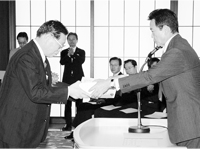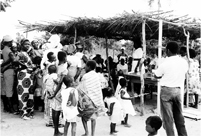Japan's Official Development Assistance White Paper 2007
Column 7 International Medical Cooperation in Africa
— Recalling Activities at the Noguchi Memorial Institute for Medical Research —
Doctor Minoru Sakurai, Former Professor, Department of Pediatrics, Mie University School of Medicine (contributor)
Ghana is the place where Dr. Hideyo Noguchi conducted his research on yellow fever and eventually died from the fever. In 1979, in honor of the doctor's accomplishments, the Noguchi Memorial Institute for Medical Research was established with Japan's grant assistance. Since then, Japan has actively supported the research institute,* which gave worldwide recognition to the institution as a top-level research institute in West Africa. The institute has been officially certified as a research center for infectious diseases by WHO. This proves that the Institute is held in high esteem. In this Institute more than 200 Japanese experts have been involved in medical cooperation. For example, Professor Sakurai engaged in projects at the Institute as a pediatrician for nearly 15 years from 1981, working earnestly to improve the child health and sanitation in Ghana. He also made a major contribution to medical cooperation in Africa through projects on infectious diseases in Zambia, on maternal and child health in Tanzania and so on. Such contributions led Dr. Sakurai to be awarded a first grade medal from Zambia in 1990 and the Japanese Foreign Minister's Award in 2007. The following is a story at the research Institute by Dr. Sakurai.
The medical cooperation in Africa initiated by the pediatrics section of the Medicine Faculty at Mie University began in 1982. Upon a request from JICA, the university decided to support the epidemiology department of the Noguchi Memorial Institute for Medical Research as the successor to the pediatrics department of Fukushima Medical University. It was not easy to dispatch experts to Africa as there was a dearth of pediatricians in charge of community healthcare. Professor Hitoshi Kamiya (Honorary Director of Mie Sanatrium and National Mie Hospital), who participated in the preliminary feasibility study, convinced Dr. Sadayoshi Torigoe who specializes in infectious diseases to work in Accra, Ghana's capital city, from April 1983. At that time, the Institute had just launched grassroots activities related to maternal and child health, having established a clinic in Fete, a fishing village with a population of 1,300. In the clinic, they were to conduct medical checkups and immunization for infants and children and epidemiologic investigations on infectious diseases.
I had the opportunity to visit Africa several times as a member of the mission. Ghana was influenced, then, by the second oil shock and there was drought for consecutive years in the country, and long lines at gas stations. Due to food shortages, Institute staff had to return home during lunch breaks in order to water vegetables in their gardens. Some senior staff members left the Institute to work in the United Kingdom or elsewhere.
Our living quarters were the official residence of the University of Ghana, located on the top of a small hill where we can see the monument of Black Star Square. At the beginning, we did not have running water and had to use only one bucket of water provided every morning: we used this for everything from washing our faces to going to the bathroom. Yet, I was able to enjoy the nature of Africa at dawn upon hearing the chirping of all kinds of birds. Some of the experts dispatched got tans and beards during the fieldwork and their family and other experts who newly arrived were sometimes very surprised to see their new rugged look.
The director of the Institute at that time was Dr. F. C. Grant, a good-natured, honest scholar. Professor F. K. Nkrumah was later assigned to that position. Professor Nkrumah was the son of the former president and a director who had a sense of the nation's mind in the aspect of Institute administration, as well as scientific study. Dr. Grant also spent a night at my small house when he visited Mie University. I remember when Dr.Grant slept on tatami mats for the first time, his legs were sticking out from futon mattress since he is a tall man. His experience of spending the night at my house apparently left a strong impression on him.
Since participating in projects at the Noguchi Memorial Institute for Medical Research, I have been also involved in a project at the University Teaching Hospital of the Zambia University Medical School, and a project on maternal and child health in Tanzania. Through these projects, we were able to dispatch a total of 25 long-term experts from the pediatrics section of the Medicine Faculty at Mie University. The accomplishments of these projects go beyond a medical technology transfer and have extended to exchanges on many levels until today. It is said that, in 2007, 12 of the 46 medicine faculty students of Mie University chose to take part in overseas training in Africa.
It is worth mentioning that all doctors that have been in Africa acknowledge the significance of their experience. These doctors have considered their own health services from a broader perspective after returning home from Africa and have gained the skills needed to resolve practical issues. I am also delighted that some of the doctors continue medical activities in developing countries through JICA and WHO.

Dr. Sakurai receiving the Foreign Minister's Award (left)

People gathering at the clinic in Fete, Ghana for treatment and vaccinations (Photo: Dr. Sakurai)


 Next Page
Next Page